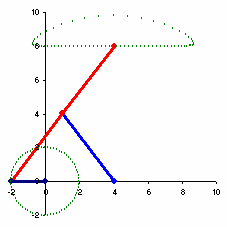Solving System of Equations using Gauss Elimination Method (Part 2)
The the previous post [Solving System of Equations using Gauss Elimination Method (Part 1)], the basic information regarding Gauss Elimination Method has been shared. In this post, we will have at more details about Gauss Elimination method.
Why called "elimination"?
The general form of system of equations is like this.

The Gauss Elimination method starts from forward elimination by dividing equation (1) with coefficient of x1. Equation (1) now becomes:

Multiply equation (1) with coefficient of x1 from equation (2) then we get:

Then we subtract equation (2) with equation (1). Equation (2) becomes:

Or we can write it as

Repeat the same procedures for the remaining equations and we get the system of equations as follows:

We can see that the first term in equation (2) to (n) are eliminated for this round of calculation. For the next round, we will repeat the same procedure, only we change the coefficient to equation (2) i.e. dividing equation (2) with a'22 and multiplying it with a'32 ... As soon as we do the forward elimination until round (n-1) we will get the system of linear equations that is ready for backward substitution as follows.

Where: the superscript ', ", ... (n-1) means number of round of forward elimination
We can find from the above system of equations that, first, we can compute the value of xn from equation (n) from:

Then we can calculate for xn-1, xn-2, ..., x2, x1 by backward substitution using the following equation.

The excel program we developed to solve system of equations using Gauss Elimination method is based on the above equations with some improvements. We will discuss later in the next post about the limitation of Gauss Elimination method with improvement method.
Further reading:
Why called "elimination"?
The general form of system of equations is like this.

The Gauss Elimination method starts from forward elimination by dividing equation (1) with coefficient of x1. Equation (1) now becomes:

Multiply equation (1) with coefficient of x1 from equation (2) then we get:
Then we subtract equation (2) with equation (1). Equation (2) becomes:

Or we can write it as

Repeat the same procedures for the remaining equations and we get the system of equations as follows:

We can see that the first term in equation (2) to (n) are eliminated for this round of calculation. For the next round, we will repeat the same procedure, only we change the coefficient to equation (2) i.e. dividing equation (2) with a'22 and multiplying it with a'32 ... As soon as we do the forward elimination until round (n-1) we will get the system of linear equations that is ready for backward substitution as follows.

Where: the superscript ', ", ... (n-1) means number of round of forward elimination
We can find from the above system of equations that, first, we can compute the value of xn from equation (n) from:

Then we can calculate for xn-1, xn-2, ..., x2, x1 by backward substitution using the following equation.

The excel program we developed to solve system of equations using Gauss Elimination method is based on the above equations with some improvements. We will discuss later in the next post about the limitation of Gauss Elimination method with improvement method.
Further reading:



Comments